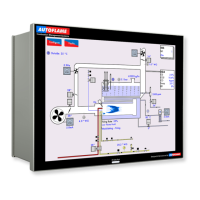6 Draught Control
04.09.2016 Mk8 MM Expansion Features Installation and Set-Up Guide Page 101
6 DRAUGHT CONTROL
6.1 Overview
6.1.1 Benefits of Draught Control
Draught control is used to manage the excess draught from stacks, in both fire-tube and water-tube
applications, so heat transfer from the hot gases to the boiler tubes can be optimised. Both heat
transfer rate and combustion rate depend on the motion of the flue gases; any changes in boiler
pressure can affect the amount of combustion air entering the burner, possibly resulting in unburnt fuel.
An excess of unburnt fuel can lead to unsteady combustion with dangerous consequences. A tall stack
is susceptible to a changing pressure which is caused be stack temperature and wind velocity. The main
benefits of maintain stack pressure through draught control include:
Improves heat transfer
Improves combustion efficiency
Reduces room heat loss
Improves flame stability while reducing chance of pilot light failure
Improves flame retention
Reduce soot accumulation
6.1.2 Fully Integrated Draught Control
The Autoflame draught control stores the pressure conditions at the commissioning stage and
modulates with the firing curve to maintain this, irrespective of changing firing rate and stack
conditions. Normally there is a vertical main stack which has a horizontal cross connection from the
boiler flue gas outlet; this is then connected into the main stack.
The boiler only works at optimum efficiency when all of the conditions that effect its operation are held
at good commissioned values. Therefore under the new arrangement, a butterfly valve driven by a
positioning motor, is placed in the horizontal back flue typically two or three metres from the boiler. A
differential pressure sensor is then inserted into the flue that is between the boiler outlet and the
butterfly valve. As stack energy alters, the suction or pressure would vary at this point. It can be seen
that by measuring the pressure of the draught at the position of the damper could be adjusted to bring
the pressure or suction back to its commissioned value, the complete system would then be operating at
optimum efficiency again.
Figure 6.1.2.i Stack with Draught Control

